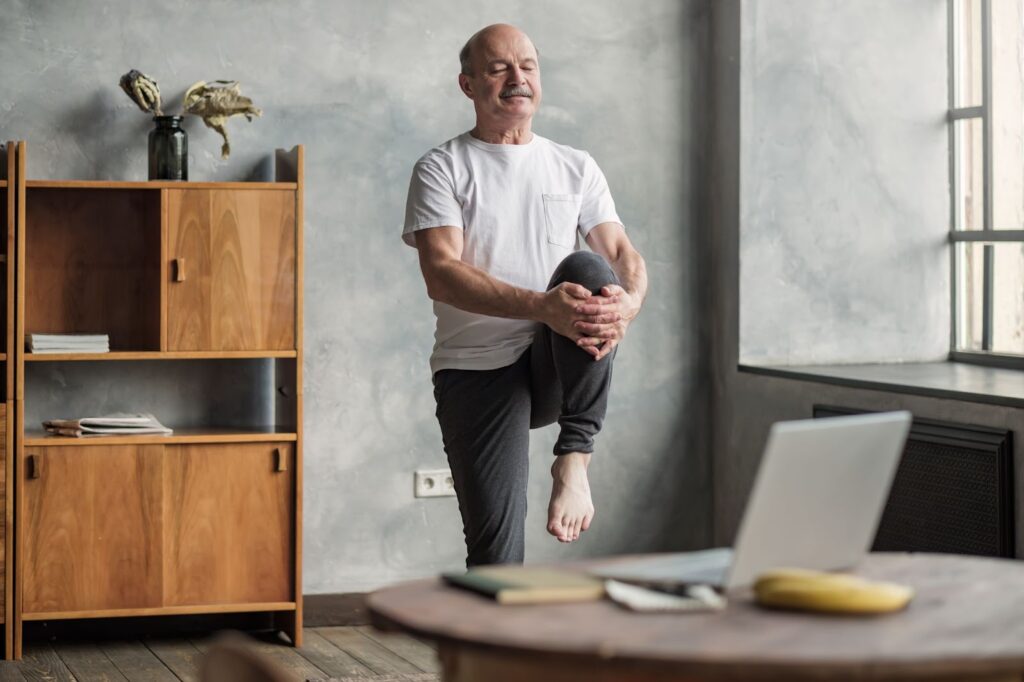We may not recognize it now but balance is an important component of our mobility that helps to reduce the risk of falls as we grow older.
Practicing and strengthening balance by incorporating them into physical routines has both physical and cognitive health benefits for older adults.
Importance of Physical Exercise
Regular physical activity is important for everyone, especially for older adults. Physical exercise enhances overall well-being, reduces the risk of chronic disease, and improves mental health.
Older adults are encouraged to have 150 minutes of moderately intense physical activity weekly, strength training twice a week, and incorporate balance into their physical routine at least once a week.
Role of Balance in Senior Fitness
Balance is often overlooked but is integral to fitness in older adults. Improving balance can help prevent falls, which are a leading cause of injury among older adults. Better balance can also enhance mobility, making everyday activities like walking, reaching, and bending safer and more manageable.
Balance exercises don’t just benefit the body; they also stimulate the brain. Engaging in activities that require balance can help enhance neural connections, improve coordination, and boost cognitive function. These exercises stimulate areas of the brain responsible for motor control.
Believe it or not, working on balance can also promote physical strength. Many balance exercises involve using multiple muscle groups, which helps build and maintain muscle mass. This increased strength can contribute to better stability and overall physical health, making daily tasks easier and safer to perform.
Cognitive Benefits of Balance
For older adults experiencing cognitive decline, balance exercises can offer significant benefits. Activities that challenge balance also challenge the brain, which helps stimulate cognitive function.
Studies have shown that engaging in balance exercises can improve memory and focus. This is because these activities require concentration and coordination, stimulating different parts of the brain.
Physical activity, including balance exercises, has been proven to reduce symptoms of anxiety and depression. For seniors, maintaining mental health is just as important as physical health. Balance exercises offer a dual benefit by improving both physical stability and mental well-being.
Simple Balance Exercises
Incorporating routine balance exercises doesn’t have to be complex. Some simple balance exercises include:
- Standing on One Foot: This exercise is as simple as it sounds. Stand behind a sturdy chair and hold onto the back for support. Lift one leg and hold the position for 10 seconds. Lower your leg and repeat with the other leg. Aim for 3-5 repetitions on each side. This exercise helps improve balance and strengthens the legs.
- Heel-to-Toe Walk: Walk in a straight line, placing the heel of one foot directly in front of the toes of the other foot. Use a wall or counter for support if needed. This exercise improves balance, coordination, and lower body strength. Aim for at least 20 steps.
- Side Leg Raises: Stand behind a chair for support. Slowly lift one leg out to the side, keeping it straight. Hold for a few seconds and then lower it back down. Repeat 10-15 times on each side. This exercise helps strengthen the hip muscles and improve balance.
Start your day with a few balance exercises. Incorporate them into your morning routine to ensure they become a regular part of your day. For example, stand on one foot while brushing your teeth or practice heel-to-toe walking while moving around the house. This makes it easier to fit exercise into a busy schedule.
Group Exercises For Balance
Joining a group exercise class can provide motivation and make exercising more enjoyable. Many communities offer balance classes specifically designed for older adults. Participating in group activities can also provide social benefits, reducing feelings of isolation.
Exercises like barre, pilates, and yoga can be practiced in a group setting or individually. Incorporating elements from yoga, Pilates, and barre into your routine can offer comprehensive benefits for balance. Each discipline helps strengthen the core and lower body in different ways, particularly in the core and lower body, which are vital for balance. The mindfulness aspect of these practices enhances concentration and body awareness, contributing to better balance.
Barre workouts involve small, repetitive movements that build muscle. Full-body engagement and emphasis on maintaining proper posture during barre enhances overall balance. Many barre routines include exercises that challenge stability, such as standing on one leg or performing movements on tiptoes.
Pilates places a strong emphasis on core strength, which is important for maintaining balance. Pilates encourages mind-body connection, precision, and concentration.
Yoga improves overall flexibility, reducing stiffness and making it easier to maintain balance. Yoga enhances body awareness, helping individuals understand their body’s position in space. The emphasis on mindfulness and focus in yoga can improve concentration, aiding in better balance.
How Caregivers & Families Can Provide Support
Caregivers and families play a significant role in encouraging and promoting the well-being of their loved ones.
Create a safe environment, especially when practicing balance exercises. Remove tripping hazards, provide good lighting, and use sturdy furniture for support. A safe environment can help reduce the risk of falls and make exercise more comfortable.
Keep track of progress and adjust exercises as needed. Gradually increase the difficulty of exercises to continue challenging the body and mind!
Schedule a Visit!
Balance exercise helps stimulate brain function, encourage physical activity, and promote social activity, all of which help to enhance cognitive function and overall well-being in individuals experiencing cognitive decline.
Our community at Liana of Sarasota provides residents with the opportunity to engage in social activities that stimulate cognitive function and encourage physical activity. Connect with us today to schedule a tour and learn more about memory care living!



